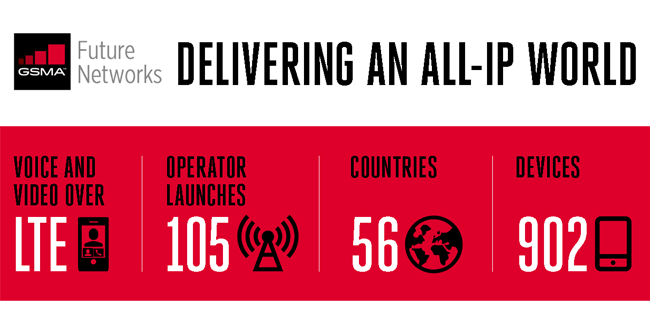Trends and Analysis: LTE Network Launches on Rise
By Henry Calvert, Head of Future Networks programme, GSMA
May 2017
Since my last update there have been a number of developments in the roll-out and adoption of all-IP communications services by our members the global operator community, such as Voice-over-LTE (VoLTE), Voice-over-Wi-Fi (VoWiFi) as well as the Universal Profile for Advanced Messaging. These are tracked by our in-house analyst team, GSMA Intelligence, with data supplied directly by our members which allows us to provide an accurate picture of key market developments. The data outlined in this blog tracks developments from January to March 2017 as well as some current statistics. To keep an eye on how things are progressing, you can track it all on our All-IP Statistics website, where the data is regularly refreshed.
Fundamental to the delivery of IP based services is the launch of LTE networks and we have seen a lot of activity in this area since our last update. There have been 606 LTE launches in 194 countries at time of writing (up from 590 at the end of the Q1 2017). This means that high speed mobile broadband services are now available to approximately 70% of the world’s population. Voice over LTE services (VoLTE) are also growing steadily providing subscribers with more reliable calling and HD voice services. There have been 105 operator launches in 56 countries to date with services available on 906 different devices. At the beginning of the year, O2 (Czech Republic) and 3 (Sweden) launched VoLTE in January, with 3 (Denmark), Telekom Slovenije (Slovenia) and O2 (United Kingdom) all launching in March. There were a small number of VoWiFi launches in this quarter with Optus (Australia) launching in January and O2 (United Kingdom) launching in March. To date there have been 54 operator launches in 31 markets.
The GSMA’s Universal Profile for Advanced RCS messaging (UP) is also going from strength to strength since its launch a year ago, with support from 76 operators, OEMs and OS providers worldwide. Sprint and Rogers have already gone live with the service which provides enhanced messaging such as group chat, read receipts and stickers in a global, interoperable and consistent way. Operators also now have the option to use end-to-end RCS solutions from Google, Samsung or their own RCS platform. The GSMA will issue a second version of the release in summer that includes new features such as Messaging as a Platform, APIs, plug-in integration, improved authentication and app security. It will also include technical enablers to allow operators to launch value-added services such as payment services, chatbots and conversational commerce.
We have also recently updated our programme name to ‘Future Networks’ from ‘the Network 2020 programme’ to reflect our new focus on the expansion from 4G to 5G connectivity. All of these developments highlight how operators are moving to deliver all IP-based services to their subscribers. The GSMA is working to support operators in this transformation towards 5G technologies and help them capitalise on the new opportunities that IP based technologies will usher in. This will also focus on our previous work to make it easier for operators to upgrade Person-to-Person (P2P) services such as Rich Communication Services (RCS) as well as new interconnection models.
